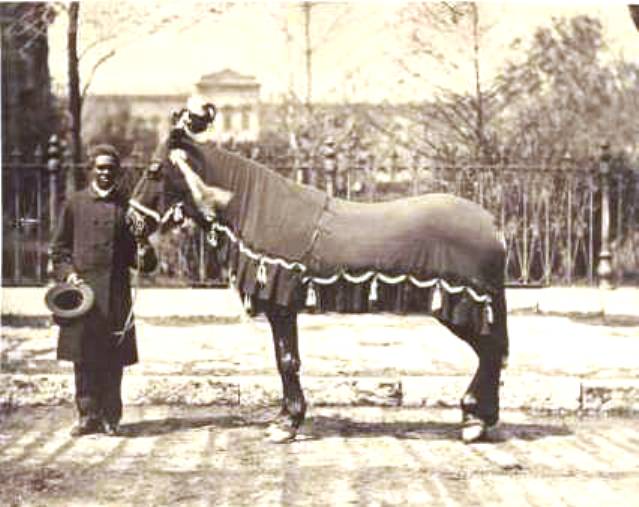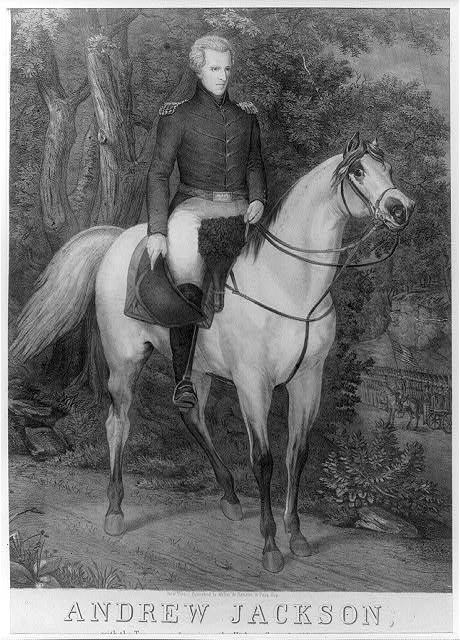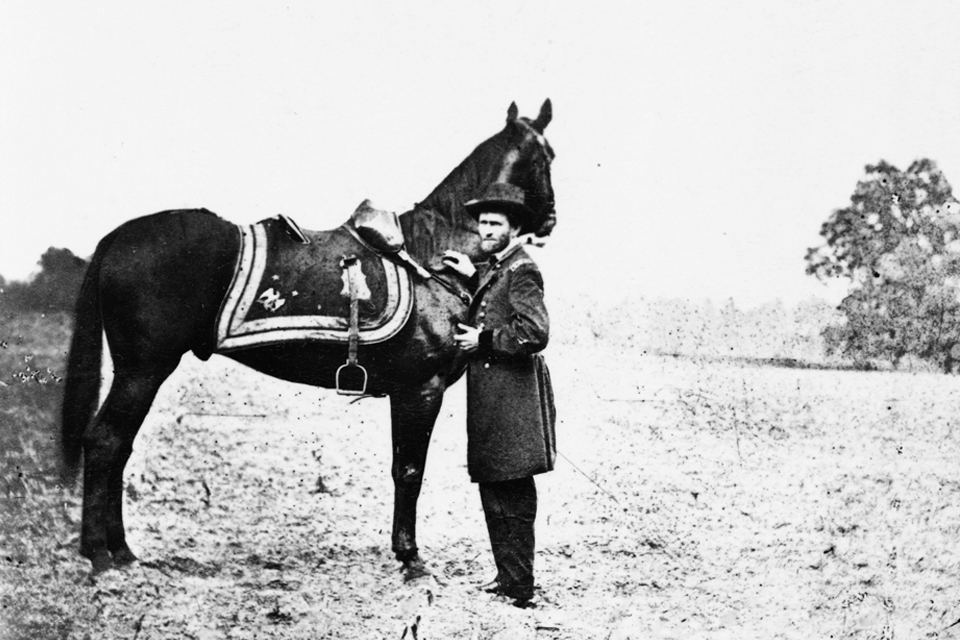There are but three Constitutional requirements to become President of these United States: must be a natural born citizen, must have lived in the country for no fewer than 14 years, and must be at least 35 years old. But if history is any indication, you could almost add another: must be able to ride a horse.
Horses are as much a symbol of America as the bald eagle and all-you-can-eat-buffet. Considering more than half the US Presidents relied on horses for everyday conveyance, it’s not surprising to see so many famous photos and paintings featuring the Executive Equine. Getting photographed on a horse is as critical a component to Commander-in-Chief optics as kissing babies and pretending to care about people. After all, if you don’t have command in the saddle, how can we expect you to help command the entire free world?
Horse stables were a fixture at the White House up until 1911, when William Howard Taft ordered their demolition to make room for a four car garage. Typical Taft. I mean, look at that galoot:

“Dude, where’s my automobile? Need to swing through Sonic on the way home.”
The White House Historical Association has an entire site devoted to the equestrian history of the Presidents, but only Horse Network dared to rank the USA’s top 10 most equine savvy Presidents in history.
*All images courtesy of the Library of Congress unless otherwise noted.
10. Lyndon B. Johnson

Johnson showing off his skill on Lady B, a Tennessee Walking Horse. (Getty Images)
One of only two modern Presidents on the list, LBJ was no stranger to the saddle. The Texan grew up cutting cattle on the ranch, a hobby he picked back up in retirement. With his southern drawl, cowboy boots and bolo tie, LBJ always seemed better suited to life on the ranch than life in Washington.
9. Abraham Lincoln

This Kentucky farm boy was certainly a capable horseman and held them in high regard. When a fire broke out in the White House stables, as the story goes, Ol’ Abe had to be physically restrained by staff after attempting to run into the inferno to save his son’s ponies. His most well-known horse was Old Bob, who famously caparisoned the fallen President at his funeral.
8. William Henry Harrison

Trading in a decorated military career, Harrison plunged into politics but not before establishing a successful horse breeding operation. Around the end of the 18th Century, the Ohioan was considered one of the most prominent breeders in what was then the Northwest Territory.
7. Zachary Taylor

When the former Major General of the US Army moved into the White House, he took his beloved warhorse Old Whitey with him. It’s said that Old Whitey would often graze in the White House lawn and it was common for visitors to pluck a hair or two for a lovely parting gift.
6. Thomas Jefferson

Like several of the founding fathers, Jefferson was a full-scale farmer, skilled foxhunter and respected horse breeder. Monticello bred many notable horses including Jefferson’s prized Caractacus, a close descendant of the Godolphin Arabian.
5. Andrew Jackson

Old Hickory had a famous thirst for sport and bred thoroughbred racehorses on his Tennessee estate, The Hermitage. When he left Nashville for Washington he brought his stable with him. That’s right, the White House became a fully functioning breeding, training and racing operation. Awesome.

Jackson’s White House Stables. (White House Historical Society)
4. Ronald Reagan

(Reagan Library)
Though he played one in the movies, Reagan was quite the cowboy himself and without question the most equine adept POTUS in the modern era. A reserve cavalry officer in the 1930’s, Reagan eventually became one of Hollywood’s most sought after cowboys. Even after embarking on his meteoric political career, Reagan always made time for equine therapy…which posed an entirely new problem: finding secret service detail that could keep up. In 1981, history’s first Mounted Secret Service Unit was sworn into service.
3. George Washington

Our nation’s first and most revered Commander-in-Chief was also the consummate horseman. Perhaps no other President spent more time nor accomplished as much on horseback as G-Dub. Thomas Jefferson called him “the best horseman of his age and the most graceful figure that could be seen on horseback.” An avid hunter, breeder and racing enthusiast, Washington’s Mt. Vernon was an equestrian’s paradise. For many years it was also home to his prized warhorse, Nelson.
“Oh, you’ve ridden in a Grand Prix? That’s awesome. I once rode my horse into battle in the Revolutionary War.”
2. Ulysses S. Grant

By all accounts POTUS #18 was a true equestrian savant, considered by many to be the greatest pure horseman to ever hold the ultimate office. His natural touch and feel with horses was evident from an early age, and his riding ability made him a standout at West Point and later in the US Army he would eventually control. He was known as a fearless rider in the saddle with the subtlety to break even the most fiery of colts. Grant’s most famous horse, Cincinnati, was the son of the great thoroughbred stallion Lexington, and was his preferred means of transportation during the Civil War.
Accolades aside, perhaps Grant’s most notable executive equestrian exploit was the time he got busted for speeding while driving his coach through the streets of D.C.. Yes, the sitting President and celebrated war hero was popped for speeding just a few hundred yards from the White House, as reported in The Washington Post:
William West is the horseman who once arrested a president. He forced President Ulysses S. Grant to go with him to the police station where he booked the chief executive on charges of speeding. Grant was driving his favorite team of horses at what West thought was excessive speed. He ordered the president to stop, chased him down, gave him a lecture in approved modern traffic cop style, and then arrested him.
What can you say? The man had a need for speed.
1. Theodore Roosevelt

While many Presidents were accomplished riders and breeders, no one embraced the lifestyle quite like Teddy. His rugged cowboy persona was more than just political posturing, it embodied what he called his approach to “the strenuous life.” In 1898, he helped establish the 1st United States Volunteer Cavalry, famously known as the Rough Riders, to assist in the Spanish-American War. Even while in office Roosevelt did not neglect his cowboy ways. When White House officials tried to give him an automobile for state duties, he famously refused. “The Roosevelt’s are horse people,” he remarked.
Damn right, Ted. Roosevelt was so serious about his riding that anyone invited to accompany him on the trails was given a printed copy of his Rules of the Road. Here they are, courtesy of the White House Historical Association:
Roosevelt’s Rules of the Road
1: The president will notify whom he wishes to ride with him. The one notified will take position on the left of the president and keep his right stirrup back of the president’s left stirrup.
2: Those following will keep not less than ten yards in the rear of the president.
3: When the president asks anyone in the party to ride with him the one at his side should at once retire to the rear. Salutes should be returned only by the president, except by those in the rear. Anyone unable to control his horse should withdraw to the rear.




 February 17, 2014
February 17, 2014 






















